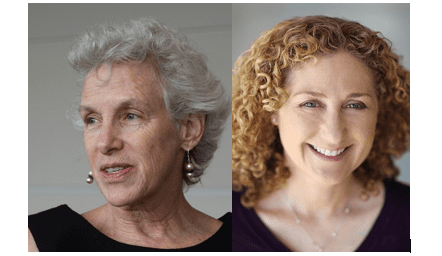UC Law SF Center and Emtrain Partner to Teach Companies How to Better Retain Employees

Professor Joan Williams, left, and Emtrain CEO Janine Yancey ’92, right.
Want to lower incidences of bias and harassment in the workplace? It all starts with respect.
Those were some of the findings of a research report conducted in partnership between the UC Law SF Center for Work Life Law and Emtrain, an eLearning and analytics company founded by UC Law SF Alumna Janice Yancey ’92. UC Law SF and Emtrain joined forces to help companies understand how addressing these issues can help them retain and recruit employees.
The report “A Data-Driven Approach to Winning the War for Talent,” released this week, looked at recent workplace data from 22,000 employees across different industries, which showed that respect, bias, and incidences of sexual harassment in the workplace are all linked. The research found that employees whose workplace experience showed bias and a lack of respect and inclusion were more likely to report incidents of harassment.
“The takeaway message here is clear,” said Joan C. Williams, Director of the Center for WorkLife Law. “Respect, authenticity and belonging, and confidence in career development opportunities are all impacted by workplace bias. Furthermore, sexual harassment is strongly linked to bias, belonging, and confidence in career development opportunities.”
“This should serve as a wake-up call for companies that take a siloed approach to their Diversity, Equity and Inclusion, culture, and anti-harassment initiatives,” said Yancey. “This siloed approach is flawed: because these issues are linked, organizations committed to creating lasting change need to address respect, inclusion, respect, bias, and harassment in a holistic manner. Companies that ignore the connection between these initiatives expose themselves to greater risk and are at danger of losing valuable talent.”
The findings in the co-authored report suggest the issues can be challenging for organizations that tend to manage harassment, inclusion, and respect in different functional silos. For instance, human resources teams select anti-harassment training and learning, then development teams deploy it. Or, legal teams manage discrimination and harassment complaints and claims to protect the organization from financial and reputation risk, and diversity leaders are tasked with inclusion, many of them in newly created positions across leading companies and in silos.
Williams said, “I wanted to partner on this project because I like Janine personally, like the fact that she is a woman entrepreneur, and like the fact that she is a Hastings grad – kind of a homerun for me. I think the results will help employers see that they should not treat issues of diversity and inclusion, compliance, and culture issues as separate and distinct, but instead will encourage them to integrate those budgets and take an integrated approach to addressing all three of these closely intertwined issues together.”
Yancey spent a decade as a labor employment lawyer before founding and becoming CEO of Emtrain, which offers a variety of cases and lessons for companies, including education on Diversity and Inclusion, Bias, Disabilities and even how to use the correct employee pronouns, to improve workplaces and give managers and executives the tools they need to retain employees.